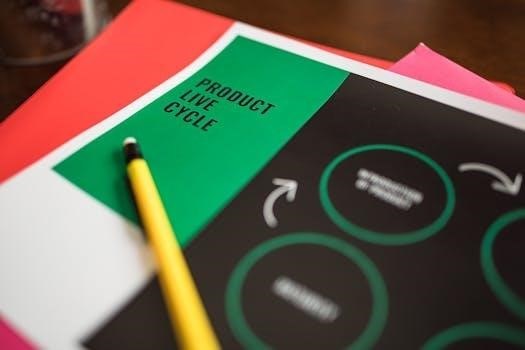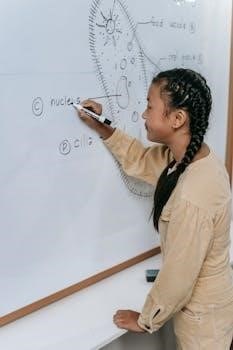y plan wiring diagram pdf
- Published
- in United Kingdom
Understanding Y Plan Wiring Diagrams
Y plan wiring diagrams are essential for understanding central heating systems. These diagrams illustrate how components like boilers, pumps, and thermostats connect. A PDF version offers a portable and detailed view of the wiring. They often include symbols and color-coded wiring for clarity during installation or troubleshooting.
What is a Y Plan Heating System?
A Y Plan heating system is a common configuration used in UK homes to control both central heating and hot water. It employs a three-port mid-position valve to direct hot water from the boiler to either the radiators, the hot water cylinder, or both simultaneously. This system provides flexibility, allowing independent control of heating and hot water, enhancing energy efficiency. The “Y” refers to the shape of the pipework and the valve’s function, splitting the flow of water like the letter Y. It contrasts with other systems like the S-Plan, which uses separate valves for heating and hot water. A Y-Plan system offers a balance between functionality and simplicity, making it a popular choice. Understanding the components and wiring is crucial for maintaining and troubleshooting these systems. This setup allows for efficient management of the home’s heating and hot water demands. It’s a widely adopted method due to its straightforward design and control capabilities.
Components of a Y Plan System
A Y Plan system comprises several key components working in harmony. The boiler serves as the heat source, providing hot water for both central heating and domestic use. A crucial element is the three-port mid-position valve, which directs the hot water flow as needed. The system also includes a circulating pump, ensuring the water moves through the pipes efficiently. Thermostats, both room and cylinder, are essential for controlling the temperature in different zones and for hot water storage. A programmer or timer allows users to set schedules for heating and hot water. Wiring centers act as central connection points for all electrical components. Additionally, safety devices like fuses are integrated to protect the system from electrical faults. Each component has a specific role in the operation of the Y-Plan system, and their correct installation and connection are crucial for efficient performance. The interaction of these parts ensures a comfortable and well-regulated home environment.
The 3-Port Mid-Position Valve
The 3-port mid-position valve is a vital component in a Y Plan heating system. This valve has three ports and is responsible for directing hot water either to the central heating circuit, the hot water cylinder, or both. Unlike a two-port valve, the mid-position valve offers flexibility by allowing a simultaneous flow to both heating and hot water. It operates using an internal motor that moves a diverter to control the water path. The valve is often electrically controlled, receiving signals from the programmer and thermostats. When the valve is in the mid-position, it allows some water to flow to both heating and hot water circuits simultaneously, which can be necessary when both are in demand. Correct wiring of the valve is essential for its proper operation and is a focus in Y plan wiring diagrams. Its functionality ensures that the system can efficiently meet heating and hot water demands as required, making it central to the Y Plan’s effectiveness.
Y Plan Wiring Center
The Y plan wiring center is a crucial hub where all electrical connections for the central heating system converge. It acts as a central point for distributing power and signals to various components like the boiler, pump, valve, and thermostats. This wiring center usually includes terminal blocks for securely connecting wires, and it may contain fuses to protect the system from electrical faults. Some older wiring centers might even have relays, but modern systems often use more streamlined designs. A well-organized wiring center makes it easier to diagnose faults and perform maintenance. The wiring diagram specifies how each component must be connected at the center. Correct wiring within this center is paramount for the entire heating system’s operation. Faulty connections within the center are a common cause of heating system malfunctions. Therefore, clear and accurate wiring diagrams are essential when working with a Y-plan system’s wiring center, ensuring safe and efficient installation and troubleshooting.

Key Aspects of Y Plan Wiring
Y plan wiring involves understanding power supply, thermostat integration, and connections to pumps and boilers. Diagrams are crucial for correct installation. Key aspects are proper grounding, fuse protection, and the correct identification of each wire. This ensures safety and functionality of the heating system.
Wiring Diagram Basics
Understanding the basics of a wiring diagram is essential before working with any Y plan heating system. These diagrams are a visual representation of the electrical connections within the system, using symbols to denote components like the boiler, pump, valves, and thermostats. A typical diagram will show the flow of electricity and the relationships between the various devices. Key elements to look for include the live, neutral, and earth wires, often represented by different colors, which are crucial for safe and correct installation. Furthermore, wiring diagrams clarify how the system receives power, how the thermostat signals the need for heat, and how the motorized valves are controlled. They also clearly display the connections to the wiring center, where all the different elements come together. Familiarizing yourself with these symbols and connection points is the first step in troubleshooting or modifying a Y plan system. Being able to read a wiring diagram is paramount to ensuring the heating system operates efficiently and safely. Understanding these basics will make working with a Y plan wiring system much easier.
Power Supply Connections
The power supply connections in a Y-plan wiring diagram are critical for the entire system’s operation. These connections typically involve a 230V AC mains supply, which must be wired correctly to ensure safety and functionality. The live, neutral, and earth wires are the foundation of these connections, and they are often color-coded for easy identification. Incorrect wiring of the power supply can lead to serious problems, including damage to the system and potential safety hazards. The diagram will indicate where the power supply enters the system, usually at the wiring center or a fused spur. It’s imperative to use appropriately sized cabling and fuses to protect the components from electrical surges. Furthermore, the power supply wires often run to the programmer, which controls when the system is active. Diagrams also show how power is distributed to the boiler, pump, and other elements through the wiring center. Therefore, double-checking the power connections is an essential step in any installation or troubleshooting process to prevent any unwanted issues and ensure the system operates as designed. Safety first is always the best approach when dealing with the power supply.
Thermostat Integration
Thermostat integration is a crucial aspect of a Y-plan heating system, and the wiring diagram clarifies how this component communicates with the rest of the system. The thermostat, whether wired or wireless, plays a critical role in controlling the heating and hot water based on the user’s settings. The wiring diagram shows how the thermostat connects to the wiring center, using specific terminals for call for heat and hot water. Correct wiring ensures that the system responds accurately to the thermostat’s signals. In a modern system, a wireless thermostat often uses a receiver unit that connects to the wiring center, simplifying the physical connections. The diagram outlines where the live, neutral, and signal wires from the thermostat connect. Some diagrams may also show connections for a cylinder thermostat, which controls the hot water temperature. Incorrect thermostat wiring can lead to the heating system not working properly, so it’s vital to check against the specific diagram. It’s also important to differentiate the room thermostat and cylinder thermostat connections, to prevent incorrect operation. The diagram helps in making the heating efficient and reliable. The thermostat is the brain of the system, so its integration is essential.
Pump and Boiler Connections
Pump and boiler connections are vital parts of a Y-plan system illustrated in the wiring diagram. These connections ensure the correct flow of water and efficient heating operation. The diagram details how the pump receives its power and how it is activated when there is a demand for heat, either from the room thermostat or the hot water cylinder. Typically, the pump is wired to the wiring center, often with a direct connection to the mains supply via a fused spur. The boiler wiring is also crucial, showing how it receives the call for heat signal and how the mains power is connected, often through the wiring center. The wiring diagram shows the proper live, neutral and earth connections for the boiler and pump, to prevent electrical issues or malfunction. Some diagrams include specific wiring for boilers with pump overruns, which keeps the pump running after the boiler has shut off, to remove residual heat. Proper wiring ensures that the pump and boiler work in tandem, circulating water effectively. Incorrect connections can cause the heating system to fail. The wiring diagram should be consulted to confirm that the connections match the components. Always consult the boiler’s manufacturer manual for specific wiring instructions.

Practical Applications & Troubleshooting
Y-plan wiring diagrams are invaluable for system installation and maintenance. They aid in diagnosing common issues, like a boiler not firing or a pump not running. These diagrams also help when modernizing systems and identifying the correct wiring.
Simplified Y Plan Diagrams
Simplified Y-plan wiring diagrams are designed to make complex central heating systems easier to understand. They often focus on the essential connections, omitting less critical details to provide a clearer overview. These diagrams are particularly useful for homeowners and those new to central heating systems who need a basic grasp of how the components interconnect. A simplified version will typically highlight the core elements⁚ the boiler, the pump, the three-port valve, the room thermostat, and the cylinder thermostat. Key wiring paths, such as the mains supply, the connections to the valve, and the thermostat signals, are clearly indicated.
These diagrams use common symbols and color codes, making it easier to follow the wiring and identify each component. For example, live, neutral, and earth wires are generally shown in standardized colors, and components are represented by their specific symbols. Simplified diagrams are often presented as a single-page schematic, focusing on the logical flow of electricity and signals through the system. This helps in troubleshooting basic issues and understanding the fundamental operation of a Y-plan system. The aim is to reduce confusion and provide a quick reference point for understanding the basic wiring layout, making it a valuable resource for both DIY enthusiasts and professionals.
Common Wiring Issues
Common wiring issues in Y-plan systems often stem from incorrect connections, loose terminals, or damaged wiring. A frequent problem is misidentification of wires during installation or repairs, which can lead to components not functioning correctly. For instance, mixing up the live and neutral wires can cause a short circuit or damage the control panel. Another common issue is the incorrect wiring of the three-port valve, leading to problems with hot water or heating not being delivered as expected. The thermostat wiring can also be problematic, with incorrect connections causing the system to fail to respond to temperature changes.

Loose connections at the wiring center or within the components are also frequent causes of issues, resulting in intermittent faults or complete system failure. Over time, wiring insulation can degrade, leading to shorts or breaks in the circuit. Issues with the pump and boiler wiring are also common, particularly if the connections are not securely fitted. Diagnosing wiring problems requires careful use of a wiring diagram and a multimeter to test the continuity of circuits and voltage presence. It is essential to turn off the power before attempting any troubleshooting or repairs to prevent electrical shock. Correcting these issues often involves checking each connection, replacing damaged wires, and ensuring that all components are correctly wired according to the Y-plan wiring diagram.
Modernizing Y Plan Systems
Modernizing a Y-plan heating system often involves upgrading components to enhance efficiency and control. One common upgrade is replacing the traditional wired thermostat with a smart thermostat, which offers remote control and programming capabilities via a smartphone app. This allows for more precise temperature management and potential energy savings. Another aspect of modernization includes replacing older, less efficient boilers with modern condensing boilers, which are significantly more energy-efficient and environmentally friendly. The wiring center can also be updated to a modern unit without relays, simplifying the system and reducing potential failure points.
Furthermore, the three-port valve can be replaced with a modern, more reliable valve. Incorporating zone valves can also enhance the system’s flexibility, allowing for different heating zones within a building to be controlled independently. When modernizing, it is crucial to refer to the Y-plan wiring diagram to ensure that the new components are correctly integrated into the system. Wiring upgrades might also be needed to accommodate the requirements of new components, such as smart thermostats that often require a neutral wire. Careful planning and precise execution based on an updated wiring diagram will ensure the successful modernization of the Y-plan system.

Finding Y Plan Wiring Diagrams
Locating a reliable Y-plan wiring diagram PDF is crucial for both installation and troubleshooting. Many resources offer these diagrams, starting with manufacturer websites for heating system components like boilers, valves, and thermostats. Major brands such as Honeywell often provide detailed wiring guides, including specific diagrams for Y-plan systems. Online forums dedicated to electricians and heating engineers can also be valuable sources, as users often share diagrams and provide advice based on their experiences. Websites specializing in electrical and plumbing supplies may also feature downloadable wiring diagrams for various heating systems, including Y-plan configurations.
Additionally, searching online with specific keywords such as “Y-plan wiring diagram PDF” can yield numerous results, including diagrams from various sources like training materials and technical publications. It’s important to verify the accuracy and suitability of any diagram before using it, particularly those found on less reputable sources. Furthermore, YouTube can be a helpful resource for visual guidance as there are videos explaining the process of wiring, often including a downloadable PDF diagram. Always double-check that the diagram matches the components used in your specific system for accurate and safe installation or repairs.
